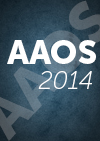
AAOS: Medial parapatellar arthrotomy VS quadriceps-sparing subvastus approach for TKA

AAOS: Medial parapatellar arthrotomy VS quadriceps-sparing subvastus approach for TKA
Functional Recovery After Total Knee Arthroplasty: A Prospective Randomized Trial Between Two Surgical Approaches
CONFERENCE ACE REPORTS
This ACE Report is a summary of a conference presentation or abstract. The information provided has limited the ability to provide an accurate assessment of the risk of bias or the overall quality. Please interpret the results with caution as trials may be in progress and select results may have been presented.
Synopsis
128 patients were randomly allocated to undergo a medial parapatellar arthrotomy or quadriceps-sparing approach to total knee arthroplasty (TKA), to determine if one technique provided superior early functional outcomes. To accurately compare results, both approaches used minimally invasive surgical principles. Short-term results revealed no statistically significant differences between groups in ...
To view the full content, login to your account,
or start your 30-day FREE Trial today.
FREE TRIAL
LOGIN
Forgot Password?
Explore some of our unlocked ACE Reports below!

Learn about our AI Driven
High Impact Search Feature
Our AI driven High Impact metric calculates the impact an article will have by considering both the publishing journal and the content of the article itself. Built using the latest advances in natural language processing, OE High Impact predicts an article’s future number of citations better than impact factor alone.
Continue



 LOGIN
LOGIN

Join the Conversation
Please Login or Join to leave comments.